×
Menu
The Wildebeest are the nomads of the Serengeti & Masai and are always on the move. Serengeti & Masai national parks are one of the oldest intact ecosystems of the earth. This whole ecosystem spans from Tanzania in the south & Kenya in the north. The national parks are on the border with no boundaries for the wild to cross. Wildebeest makes the most of it around the year, crossing the border without any hindrance from the authorities.
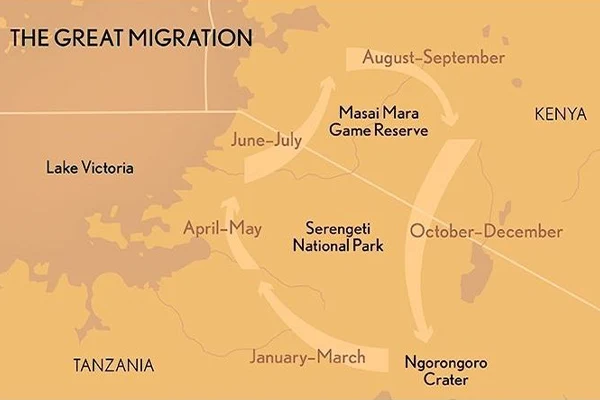
The wildebeest migration plays a crucial role in maintaining the ecosystem, which is triggered by the weather. When the thunder clouds start setting on the horizon in the south of Serengeti, the mass movement of these animals kicks off. In the quest of chasing the rains & scouting for the greener pastures to graze on, the Wildebeest start moving from the south of Serengeti up towards north & back again.
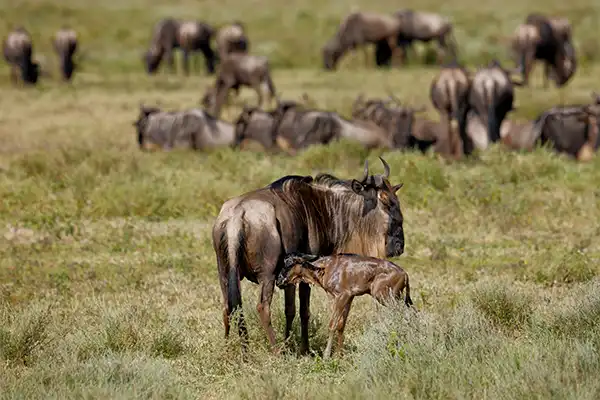
The onset of migration is in October, which is the start of the journey &, in turn, life. This is the time of the mass birth of mammals that marks the first lap of the wildebeest movement. The newborns are ready on their feet within the first 15-20 mins of their life. The first thing they do is imprint their mothers by scent & calls. It is important to do as this mega herd could be a chaotic place for the newborn to get lost. At this time of the year, nearly 200,000 calves are born, which is a part of a smart adaptive strategy. As there will be too many predators prying for the weaklings, the wildebeest outnumber themselves with so many new calves that tilts the odds in wildebeest favor.
Over the next two months, the baby calves are ready for their first pilgrim of paying their dues to the ecosystem. This movement is not just a defining piece of life but also plays a vital role in maintaining the ecosystem. As the wildebeest moves in search of lush green grasses, they act like giant lawnmowers, allowing the new shoots to grow. With millions of wildebeest dropping off their waste on the savannah plains, the land gets natural manure which helps fertilize the land for healthier foliage.
Around February, the wildebeest reach the central Serengeti, where water is available around the year. The herd spends the next few months feeding off the rich grass and nurturing the young in the wide plains. The movement of thunder clouds & rains signals the wildebeest to move further north. The rain leads them to better grazing land.
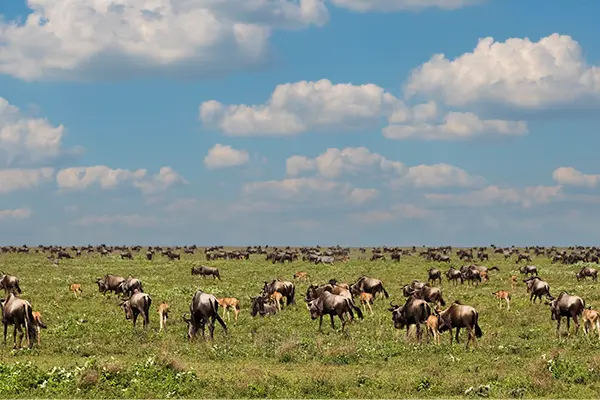
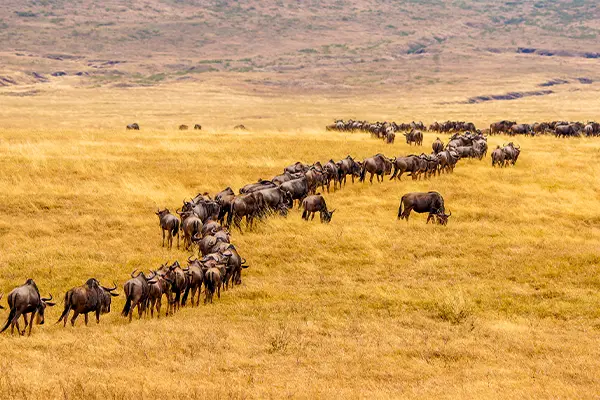
With July setting in and the rain gods reaching the north part of the land, the wildebeest start crossing the border into Kenya, moving the party to Masai Mara national park. There could be some detours depending upon the direction given by the rain god. Still, in the end, all fall back into place just in time to cross the Mara River before it gets too flooded by the rains, making it difficult to cross the waters without any swimming skills.
Though it may sound like just another travel across the border with so many preys coming in the huge bunch, the predators are looking out for food, too, just like the wildebeest. This time of the year is a feast in the plains of the savannah, where all big cats come out to grab a piece for themselves. It also plays a vital role in the territory shift for the jungle as lion prides cross each other’s territories in search of food.
Even with the low water levels in the Mara River, it could be a treacherous place to cross peacefully as it is infested with crocodiles. Crocodiles, being cold-blooded animals, are generally in hibernation mode at this time of the year. With the large herds coming in and the shocks sent to the earth with wildebeest movement, the crocodiles wake up and be ready for the food coming on a platter.
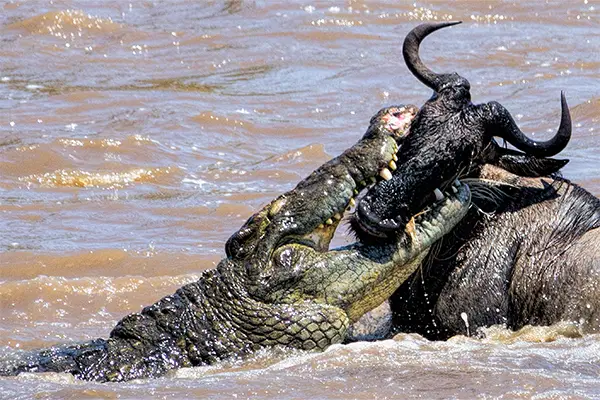
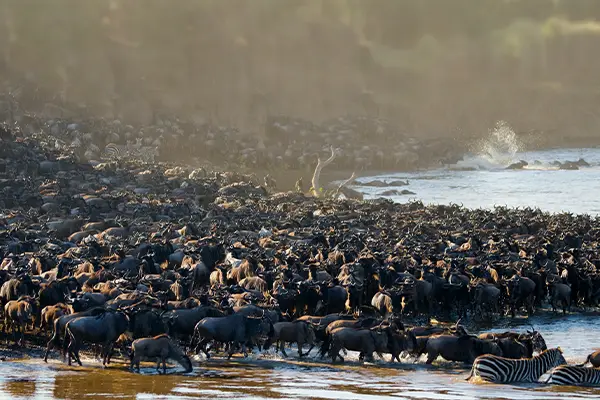
Mara River- Lifeblood Of Savannah
The Mara River is the lifeblood of the savannah ecosystem. It runs from the highlands of southern Kenya, snaking through the Tanzania border and finally emptying out in Lake Victoria. The wildebeest have to navigate through the Mara River strategically by finding a better crossing point to make the crossing. By August, the movement starts happening to cross the Mara River. The herd comprises the elders with experience in crossing the crocodile-infested Mara and thousands of young ones who are doing for the first time. The most interesting point comes when the large herds come and settle around the Mara & no one dares to jump in to cross the river. It could be a matter of a second, or the process of admiring the Mara River from the shore can sometimes go on for days or weeks. And then comes the Wildebeest warrior who takes a leap, and as goes the ancient instincts, the rest of the herd follows through, making it look like a waterfall of wildebeest in the Mara River.
During this time of crossing, the crocodiles are drawn to the commotion. They very strategically place themselves near the other end of the river, as the wildebeest herd is trying to scramble up their way to land. That is when this opportunistic animal tries to get hold of his meal. Dying by the jaws of crocodiles is not the only threat wildebeests face while crossing the river. With the herds jumping in relentlessly, the wildebeest can easily fall prey due to the broken limbs in the stampede.
And the mega herd of wildebeest continues their journey for lush grasslands, rain & saving the savannahs’ ecosystem. The endless cycle of nature and life with these nomads keeps moving, and every year wildlife enthusiasts pour in to witness this utmost wonder of nature.
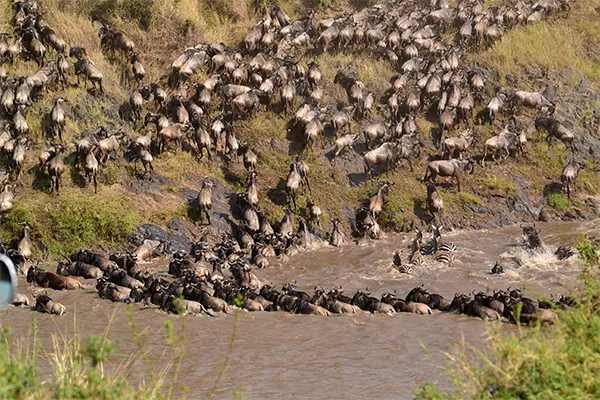
We offer the best offers with specially curated tours. Come and experience the wild and the beauty of Africa.
Book Now